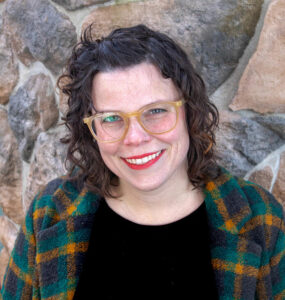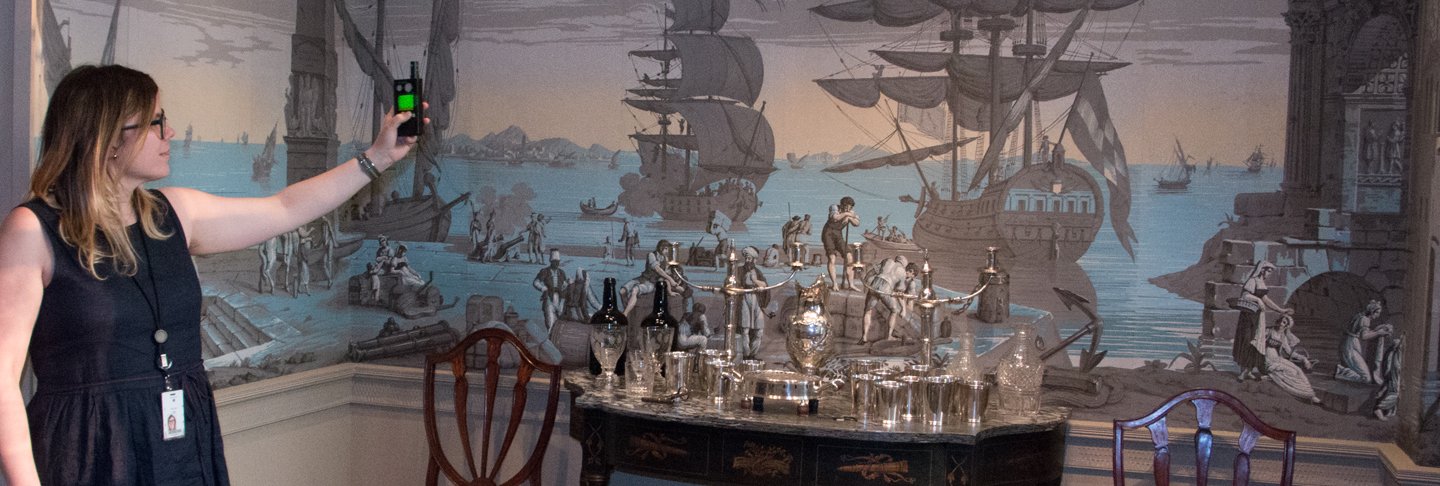The team at Conserv is growing! This week we are introducing: Melissa King. She is our new Conservation Liaison and resident preventive conservator. Most recently, Melissa served as the Samuel H. Kress Fellow in Preventive Conservation at the Smithsonian National Museum of Natural History and the Museum Conservation Institute. She graduated in 2020 from the Winterthur/University of Delaware Program in Art Conservation (WUDPAC) as the first student to specialize in preventive conservation. Melissa has a deep interest in data science for preservation and is one of the co-founders of the ConCode initiative. She also comes to Conserv with business experience as a professional pet portrait artist. (Banner Photo Credit: Evan Krape, University of Delaware)

Melissa King. Photo credit: Lauren Gottfried-Kelly
What is your role on the Conserv team?
I am the “Conservation Liaison,” which means I am working primarily on building Conserv’s connections to the preservation communities. This means direct involvement in professional organizations, collaborative research, consulting, and teaching.
Since Conserv is actively adding new features to their software, I am also contributing to product development inquiries and seeking out subject matter experts where needed. I will be actively meeting preservation professionals from around the world and learning more about ways we can create a superior preventive conservation service.
What is your experience with collections?
I have been working in cultural institutions and private art conservation practices since 2009. My experience has included: objects, paintings, paper, textiles, and preventive conservation. I’ve worked at fine art, historic houses, archaeology, and natural history museums. During my time at the Smithsonian, I had the great privilege of serving on the Preparedness and Response in Collections Emergencies (PRICE) team.
While a student at WUDPAC, I completed research into fungistats on textiles, low-cost sensors to measure mercury vapor in mirrors, the management of collection emergency kits through a Smithsonian-wide survey, measuring the passive environmental control of soft-sided crates, and models to predict the relative humidity in display cases using sorbents at the mid-RH range.
What excites you about Conserv?
Over the past few years, I have become especially interested in data science and thinking big about how we can better utilize the breadth of datasets we collect while preserving collections. For a while, I was convinced that many of these ideas would live on as mere fantasies stymied by lengthy grant funding cycles… and then I learned about Conserv.
So far, none of my ideas have seemed outside of the realm of possibility. The team has been eager to listen and they have the resources and knowledge to figure out how to make things happen (you can also share your own ideas on their Productboard!).
I am amazed by their efforts to understand the specific needs of our field, and by the speed with which they work to make improvements and expand the scope of the product. Good software requires constant maintenance and upgrades to adapt to the needs of its users, and a business model for preservation technology is essential in this instance.
In collections preservation, we are adept at finding creative solutions to suit our needs from ancillary industries. It is so refreshing to learn of a company creating a product specifically for our field, and continually finding ways to make it better.
Where do you see the company going in the future?
We are already confidently working towards incorporating integrated pest management, water leak monitoring, disaster planning, and developing features to encourage more sustainable environmental management practices. This seems ambitious, but witnessing this teamwork and seeing how actively they respond to customer feedback has dispelled any doubt I had that this company will continue to push the boundaries and work towards the next greatest thing. I am taking this question as an opportunity to share some of my wild (but totally feasible) preventive conservation hopes and dreams. Here is a sampling of what I would love to see:
- Integration into collections management systems to track the environment of an individual collection item as it moves throughout the institution
- Artificial intelligence and machine learning to build a greater understanding of the relationship between datasets (i.e. pests vs. temperature/relative humidity). I hope we can eventually utilize this relational data for predictive modeling
- Good preventive conservation is inherently collaborative, and I hope we can continue to promote stakeholders to work together within the software. Maybe even one day we could “gamify” Conserv to promote friendly competition amongst cultural heritage institutions and encourage collections professionals to regularly update their emergency management plans, check IPM traps, and log in to look at environmental data
- Why should preventive conservation tools be reserved for museums and cultural heritage institutions? I would love to see Conserv bring preventive conservation technology into our communities and work on ways to increase the overall accessibility to collection preservation.
Ideas like these are only the beginning… Innovation is fueled by collaboration, and at Conserv we LOVE to collaborate. Excellent preventive conservation requires buy-in from as many people as possible, and I look forward to figuring out ways to promote this effort.
You can follow Melissa on Twitter: @mkpreventive
If you have any questions about environmental monitoring, integrated pest management, or just want to talk about preventative conservation, please reach out to us! Don’t forget to check out our blog or join our community of collections care professionals where you can discuss hot topics, connect with other conservators or even take a course to get familiar with the Conserv platform.




